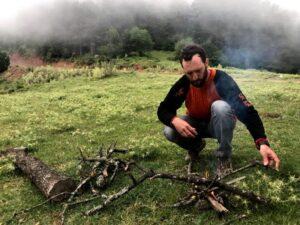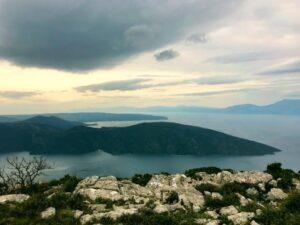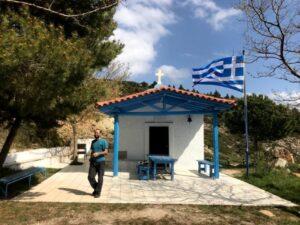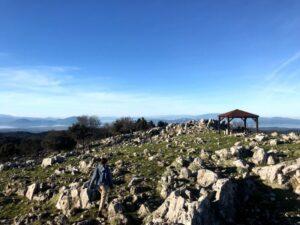If you are an outdoors enthusiast and you are planning to travel to Greece, then… congratulations! You’ve done a great choice! Greece, with its countless wild mountains, remote beaches, and astounding wilderness, offers virtually endless possibilities for thrilling hiking adventures. If you are looking for resources to help you organize your hiking trip in Greece, then you are in the right place. I have here compiled for you this post, aiming to answer most of the questions one might have in relation with hiking in Greece. In case you cannot find an answer here about anything particular you wonder about, I welcome you to contact me and I’d be happy to assist you.
Contents
- 1 Where to hike in Greece
- 1.1 Most popular hikes in Greece
- 1.1.1 Mount Olympus
- 1.1.2 Meteora
- 1.1.3 Samaria Gorge
- 1.1.4 Menalon Trail
- 1.1.5 Vyros Gorge
- 1.1.6 Vikos Gorge
- 1.1.7 Mount Pelion
- 1.1.8 Mount Athos
- 1.1.9 Corfu Trail
- 1.1.10 Fira to Oia Hike in Santorini
- 1.2 Hiking in the Greek Mainland
- 1.2.1 Hiking near Athens
- 1.2.2 Hiking on Euboea (Evia) Island
- 1.2.3 Hiking in Central Greece
- 1.2.4 Hiking in Peloponnese
- 1.2.5 Hiking in Western Greece
- 1.2.6 Hiking in Thessaly
- 1.2.7 Hiking in Epirus
- 1.2.8 Hiking in Western Macedonia
- 1.2.9 Hiking in Central Macedonia
- 1.2.10Hiking in Eastern Macedonia and Thrace
- 1.3 Hiking on the Greek Islands
- 1.3.1 Hiking on Crete
- 1.3.2 Hiking on the Cyclades
- 1.3.3 Hiking on the Dodecanese
- 1.3.4 Hiking on the Northern Aeagean Islands
- 1.3. Hiking on the Ionian Islands
- 1.4 E4 and E6 European long distance paths in Greece
- 2 Hiking Stories from Greece
- 3 What is the best time of the year to hike in Greece
- 3.1 Hiking in Greece in the winter
- 3.2 Hiking in Greece in the spring
- 3.3 Hiking in Greece in the summer
- 3.4 Hiking in Greece in the fall
- 4 Transportation in the Greek countryside
- 5 Free Wild Camping in Greece
- 6 Hiking in Greece permits and red tape
- 7 Dangers while hiking in Greece
- 8 Greek Mountains List
- 9 Greek Mountains Map
- 10 Greek Mountains Videos
- 11 Greek Mountains Photo Albums
- 12 Resources about hiking in Greece in the Greek language
Where to hike in Greece
Greece, in my opinion, is unique in that it contains an unparalleled high concentration of natural beauty in such a small area. No matter where in the country you are, you always have plenty of choices for doing a fantastic hike. In this section of this post, I intend to give you some inspiration about where to go hiking in various parts of Greece.
10 Most popular hikes in Greece
Here’s a list of the 10 most popular hikes in Greece, which are also some of the most scenic ones. These routes are especially suitable for people with less hiking experience, as the trails are well-signed and frequented. Tourist infrastructure in these areas is fairly well developed. Organized tours for these hikes are relatively easy to be found and joined. Experienced hikers, however, might prefer to skip them and look for a hike in the deep wilderness.
Mount Olympus
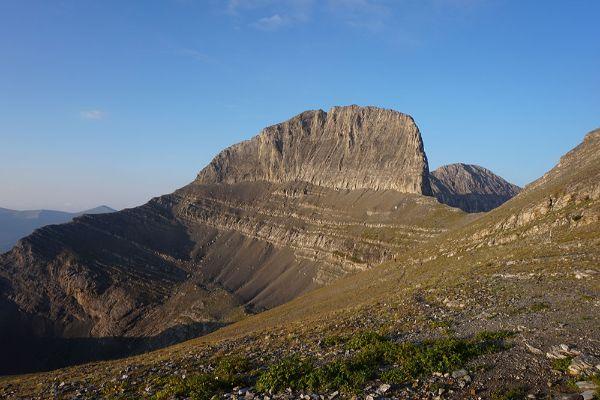
Who hasn’t heard of Mount Olympus, the all-mighty highest mountain of Greece and the abode of the ancient gods? Mount Olympus is situated in the region of Thessaly in central Greece. There are countless trails running through its lush forests, deep gorges, and high alpine plateaus. The most popular trail starts from the village of Litochoro and leads to Mytikas: the highest summit of the mountain at 2,917 meters. The round trip commonly takes 2 days with an overnight stay at the picturesque Spilios Agapitos refuge.
Meteora
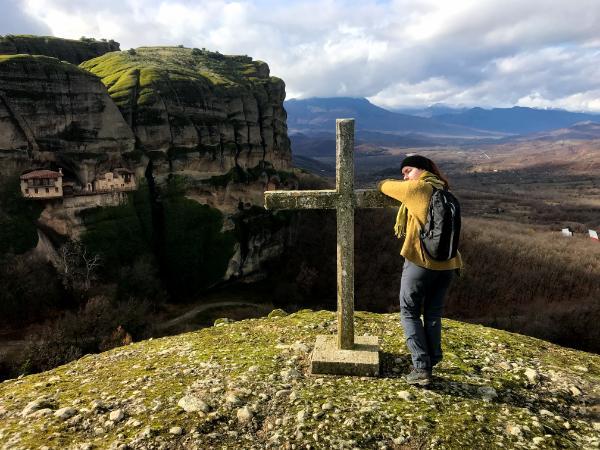
The Meteora is one of the most popular destinations in all Greece. Crowds of visitors can be found there at any time of the year. And for a good reason: the geologically peculiar tall rock pillars towering towards the sky and the centuries-old monasteries crowning their tops make this place one of the most unique on Earth, in both terms of natural beauty and historical significance. The majority of the site’s visitors make do with organized coach tours to the monasteries. For hiking enthusiasts, however, there is a multitude of beautiful trails to explore the area on foot and get the best views of the rocks and the surrounding area. Here you may check out a post from one of my own trips to the Meteora.
Samaria Gorge
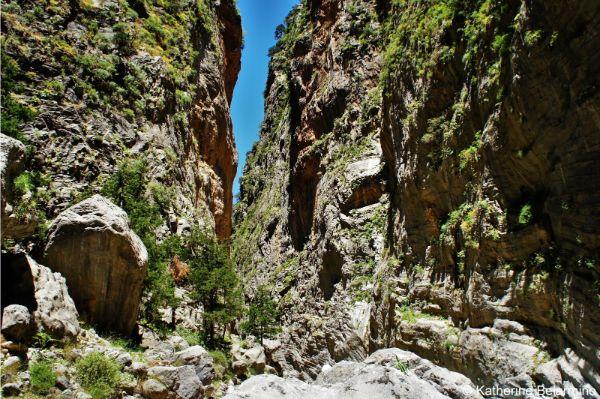
The Samaria Gorge is situated in the southern Lefka Ori mountain range on Crete. It is one of those places that shouldn’t be excluded from the bucket list of any avid global hiker. It is especially known for its peculiar flora and fauna, which have made it a World’s Biosphere Reserve, as well as its one-of-a-kind feature dubbed ‘the Gates’. That is a 4-meters-wide passage in between two 300-meters-tall, vertical rock walls. If you wonder how it feels to see only a thin strip of sky overheads, that’s the place to find it out. The hike starts at an altitude of 1,250 and, after 16 km, leads to the coastal village of Agia Roumeli. After having a delicious meal at one of the village’s seafood tavernas, one would usually catch a boat to Sfakia town.
Menalon Trail
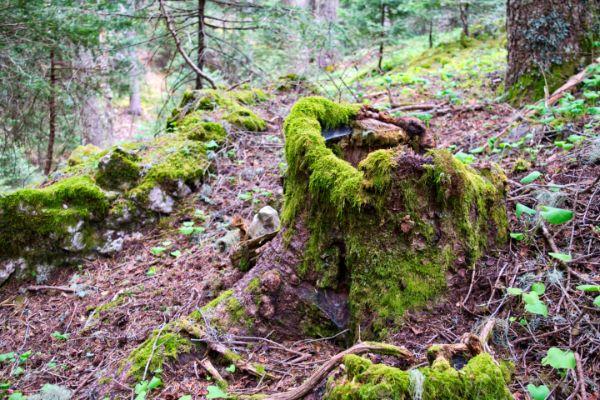
This is a 75-km-long trail running through the Menalon Mountain in Arcadia region, in the heart of Peloponnese. To complete the entire trail, it takes an average of 3-4 days. It is divided into 8 sections that can be done separately. It passes through diverse mountainous landscapes of astounding beauty, as well as various cute, picturesque village of great historical significance. You may check the trail’s official site for more information.
Vyros Gorge
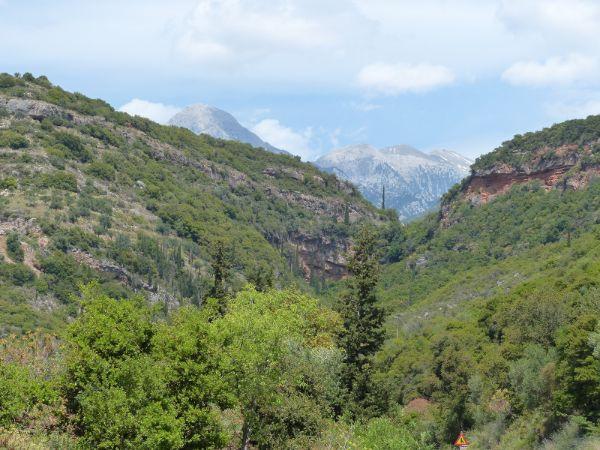
The Vyros Gorge is another of Peloponnese’s natural highlights. It is a dramatic gorge extending from the summit of Mount Taygetus down to the Messenian Gulf coast at the town of Kardamyli. The gorge is utterly dry in the summer months, whereas it’s run by a wild torrent in the winter. Several hiking trails span the gorge, many of which pass by various monasteries that are to be found within it. Here’s a post on one of my own hiking trips crossing Mount Taygetos and Vyros Gorge in 3 days.
Vikos Gorge
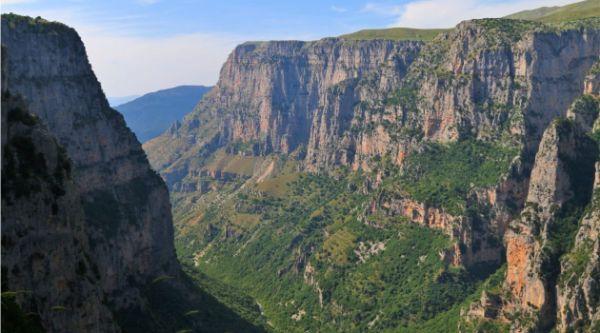
Not to be confused with Vyros Gorge above, Vikos Gorge is located in the northern Pindus Range, near the Albanian border. With a maximum depth of 490 meters, it enjoys the honor to be listed as the deepest gorge in the world. It is 20 km long and there is a multitude of hiking trails running through it, as well as over the cliffs above it. The views to be marveled at from there are outright breathtaking.
Mount Pelion
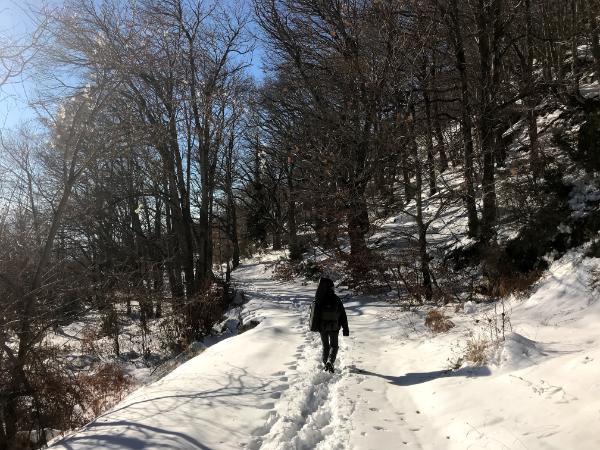
Mount Pelion forms the hook-like peninsula in Magnesia region of central Greece which separates the Pagasetic Gulf from the Aegean Sea. Especially due to its great vicinity to the sea on both sides, it offers some of the most spectacular views that may be seen anywhere in the country. The mountain has been a hotspot for human activity since times immemorial. Ancient ruins stand side by side with medieval churches and monasteries all over the mountain. The countless little villages standing perilously on the mountain’s steep cliffs are arguably amongst Greece’s most picturesque. The old mule paths that used to accommodate those villages’ communication needs, nowadays serve as recreation hiking trails that the nature aficionado can spend weeks exploring. You can here check out a story of one of my recent trips to Mount Pelion.
Mount Athos

Mount Athos is undoubtedly one of Greece’s most singular mountains. It is situated on the southernmost tip of the east peninsula of Chalkidiki region. Being mostly neighboured by sea and plains for a vast surrounding range, it also is one of the country’s most conspicuous mountains, being visible from pretty much half the country. The mountain and the peninsula in which it stands constitutes an autonomous region of Greece, inhabited and ruled only by Orthodox monks. That makes the planning of a hiking trip pretty complicated. To enter the monastic state is outright forbidden for women for over a millennium. Men should apply at least 6 months in advance in order to get permission.
Corfu Trail
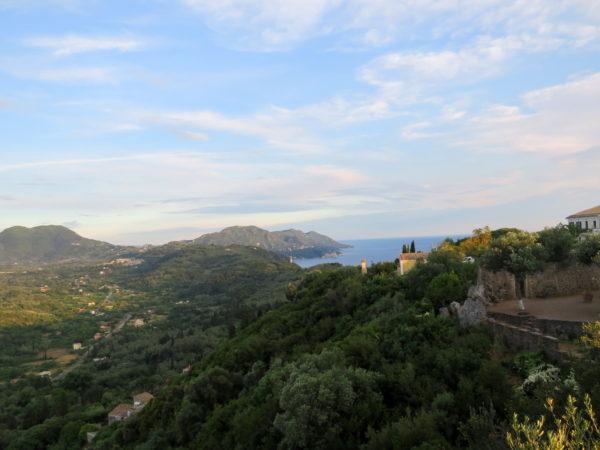
The Corfu Trail has become one of the most popular trails in Greece ever since its establishment in 2001. It spans the entire island of Corfu, covering a total distance of 220 km. The long distance compensates the hiker with some really stunning sceneries in a great variety of landscapes. It is very well signed and not physically demanding, so that it’s ideal for people without particular hiking experience and strength. You may get more information on Corfu Trail’s official website.
Fira to Oia Hike in Santorini
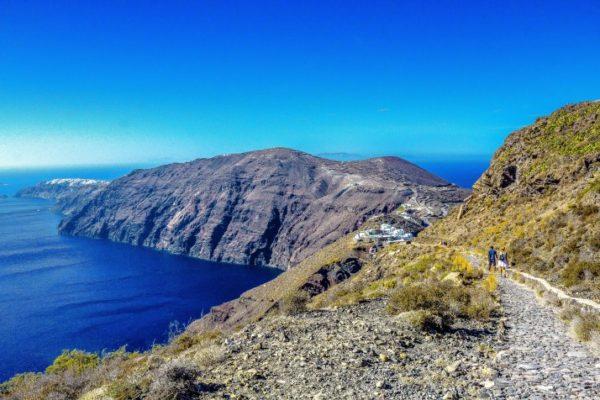
Santorini is one of the most visited destinations in Greece and couldn’t lack a popular hike of its own. That runs for 10 km along the caldera ridge between Fira town and Oia village at the north tip of the island. This is exactly where you get those amazing pictures of the blue-domed white churches at the edges of steep rocky cliffs before vast expanses of deep-blue sea.
Hiking in the Greek Mainland
Greece is a country endowed with vast expanses of mountainous wilderness that should be considered a hiker’s paradise. The endless options you run across when trying to decide where to hike, however, can become overwhelming. Below I give some suggestions about the best places to hike in different regions of Greece.
Hiking near Athens
If you happen to be in Athens and have found yourself in a desperate need for an escape to nature before you get suffocated, good news: there are plenty of nice hikes you can easily do within one day in the vicinity of Athens.
The most obvious choices are the five mountains that define the periphery of Athens. Those are:
A day trip to one of the above mountains can very easily be done even by using public transport to get there. If you have your own vehicle, within a day you can reach lots of other nice mountains to hike. Those include all the rest of Attica’s mountains, as well as certain mountains in Corinthia, Argolis, Boeotia, and Euboea regions. Some of Attica’s mountains worth to check out are:
More info on hiking near Athens:
Hiking on Euboea (Evia) Island
Euboea (pronounced ‘Evia’) is the second largest island in Greece. Throughout its 200 km length, the island brims with high rugged mountains, lush forests, and remote secluded beaches. Due to its vicinity to Athens, it makes for an ideal destination for a weekend hiking trip starting from the Greek capital.
You may reach the island from Athens either overland (via one of the two bridges connecting the island’s capital city, Chalkis, to the mainland) or by one of the two ferry lines connecting Attica to Euboea: Aghia Marina port to southern Euboea and Oropos port to central Euboea. There are also two more ferry lines connecting the north of the island to Phthiotis region.
The following are the highest mountains on Euboea which offer lots of nice possibilities for a fantastic hiking trip:
- Dirfys
- Xerovouni
- Ochi
- Pyxarias
- Kandyli
- Olympus
- Xiron Oros
- Messapion (Ktypas)
Hiking in Central Greece
Just like most of the country, Central Greece is full of extensive mountain ranges and quaint landscapes. Nice hikes to be done in the region are virtually endless. Some of the region’s most notable mountains are: Helicon, Parnassus, Giona, Vardousia, Oeta, Kallidromo, Kaliakouda, Tymfristos, and the wild Agrafa Mountains of southern Pindus mountain range.
Hiking in Peloponnese
Peloponnese is the southernmost region of mainland Greece. It certainly is one of the most opulent parts of the country in both terms of nature and culture. Some of the best mountains to hike in the region are: Kyllini, Oligyrtos, Arachnaio, Mainalo, Artemisio, Tsemperou, Parnon, and Taygetus.
Hiking in Western Greece
The administrative region of Western Greece occupies the northwestern part of Peloponnese and the western part of central Greece. The highest mountains in the region are: Erymanthos, Panachaiko, Lykaion, and Minthi south of the Gulf of Patras; Panaitoliko and Akarnanika north of the Gulf of Patras.
Hiking in Thessaly
Thessaly is the largest plain of Greece. However, that doesn’t mean that it lacks mountains. The plain is, in fact, encircled by some of the country’s most prominent mountains. Mount Olympus, to begin with, Greece’s highest and most renown mountain, as well as the famous Meteora, are located in the region. Other than those, you have Ossa, Pelion, and Orthys mountains bordering the plain to the east; and the great Pindus range to the west.
Hiking in Epirus
If there is any one region of Greece which could be said to be the best part of the country to go hiking, that would definitely be Epirus. The entire region is occupied by the high, wild mountains of northern Pindus. These are the greenest mountains in the country and they host the greatest variety of wildlife, including bears and wolfs. The region’s mountains are virtually countless. The highest of them are: Smolikas, Grammos, Tymfi, and the broad cluster of Athamanika Mountains.
Hiking in Western Macedonia
Western Macedonia is another of Greece’s regions that hosts arrays of wild mountains belonging to Pindus and Voras ranges. Its highest mountains are: Kaimaktsalan and Vermio in the east of the region; Varnous, Verno, and Askio in the middle; Voios, Vasilitsa, Lygos, and Chasia in the west. Another great option for hiking in the region is the National Park of Prespa Lake: a very pristine ecosystem with serene sceneries and rich biodiversity.
Hiking in Central Macedonia
The Central Macedonia region is where Greece’s second largest city (Thessaloniki) and second largest plain are located. As you may imagine, lots of beautiful mountains are located in the region as well. Parts of Mount Olympus and Kaimaktsalan, the country’s two highest mountains, as well as Mount Athos, the also known as Holy Mountain renown autonomous monastic state, are situated in the region. Other notable mountains include: Cholomon, Chortiatis, Kerdylio, Vertsikos, Paiko, and Kalampaka, by the foot of which, Kerkini National Park is also open to be explored.
Hiking in Eastern Macedonia and Thrace
Eastern Macedonia and Thrace forms the northeastern part of Greece, between Turkey and Bulgaria. This region also abounds with pristine mountainous landscapes for one to do a memorable hiking trip. The Rhodope mountain range along the Bulgarian border is the most obvious place to go hiking in the region. Other than that, you can check out Mount Pangaion, Nestos Delta National Park, and Dadia-Lykofis-Lefkimmi National Park.
Hiking on the Greek Islands
Thinking of Greek Islands, images of sunlit beaches, sunbeds, and parasols usually pop up in one’s brain. The hiking enthusiast will, however, ask “aren’t there any mountains on the islands?” Sure there are.
Hiking on Crete
Crete is by far the largest and most populated of the Greek Islands, and it is as well one of the most beautiful when it comes to nature. One may hike on Crete for an entire lifetime and still not run out of ideas for yet more hikes to do. Coming for a brief holiday, however, you may consider the following places for your hiking trips: Samaria Gorge, Lefka Ori, Mount Ida, Kedros, Asterousia, Dykti, and Thrypti.
Hiking on the Cyclades
The Cyclades Islands are the most popular holiday destination in Greece. Other than beaches, hotels, tavernas, and bars, all of them have their mountains as well which are worth to check out during your visit. The highest mountain in all the region is Mount Zas on Naxos Island.
Hiking on the Dodecanese
Dodecanese means ‘twelve islands’ and refers to the islands in the southeastern quarter of the Aegean Sea. Each one of them has its mountains and hiking trails. The highest mountain in the region is Mount Attavyros on Rhodes.
Hiking on the Northern Aegean Islands
The main islands found in the northern Aegean Sea are Samos, Ikaria, Chios, Lesvos, Lemnos, Thasos, and Samothraki. All of them are mountainous and offer astounding landscapes to wonder at. The highest mountains in the region are: Kerkis and Karvouni on Samos; Pelinaio on Chios; Feggari on Samothraki; and Ypsario on Thasos.
Hiking on the Ionian Islands
Lastly, the Ionian Islands, situated west of the Greek mainland, offer some amazing hiking opportunities as well. Some of the best are: the Corfu Trail; Ainos, Agia Dynati, and Kokkini Rachi mountains on Ceaphlonia; and Elati mountain on Lefkada.
E4 and E6 European long distance paths in Greece
The strenuous hiker should also consider the Greek legs of the E4 and E6 inter-European hiking trails. The E4 enters Greece from Bulgaria and, crossing the entire country, terminates on the east coast of Crete, whence it continues onto Cyprus. The E6 comes to Greece via ferry from Dubrovnik, Croatia, moves along the country’s northern border, and terminates in the city of Alexandroupoli. Check out Wikipedia’s page on Europe’s long-distance paths for more information.
Hiking Stories from Greece
Here are my hiking stories from various places around Greece. You may check them out for inspiration and information.
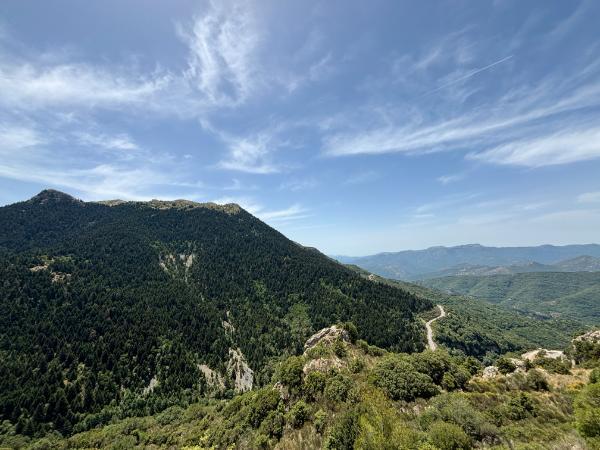
Dimitsana to Zygovisti: Menalon Mountain Trail Section 2
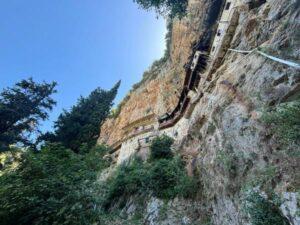
Stemnitsa to Dimitsana, Lousios Gorge: Menalon Mountain Trail Section 1
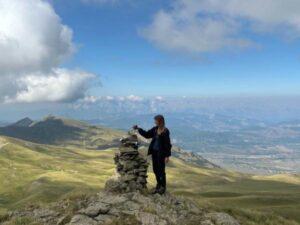
Climbing Mount Grammos from the Greek Side
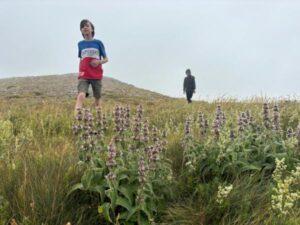
Hiking Mount Askio, Western Macedonia, Greece

Climbing Mount Smolikas & Camping at its Dragon Lake
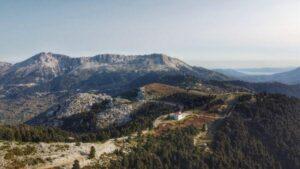
Highest Mountains on Evia Island (Euboea)
What is the best time of the year to hike in Greece
Although it is perfectly alright to hike in Greece at any time of the year, the best time is undoubtedly from April to June and from September to October. The very best month is probably May, when temperatures are at their mildest and nature at its greenest.
Hiking in Greece in the winter
Notwithstanding the images of sunlit beaches one has commonly associated with Greece, winters in Greece can be really harsh. Especially in the mountainous parts of the country, temperatures can plunge to two-digit figures below zero and snow is consistently bountiful. Hiking in the Greek mountains during the winter months is demanding and oftentimes requires alpinistic experience. Hiking at lower altitudes is generally fine for anyone but one should still be well prepared for harsh weather conditions.
Hiking in Greece in the spring
The spring months, more April and May than March (which should better be considered as a winter one), are by far the best ones to hike in Greece. Temperatures are warm but not hot. Water streams are swollen. And nature is in its most beautiful and fragrant state.
Hiking in Greece in the summer
Although this might sound counterintuitive, hiking in Greece during the summer months can be very tough. Especially in July and August, heat is extreme and water scarce. Summer may well be deemed as the worst season to do hiking in Greece. If attempted, forest trails should be preferred over the open landscape. A hat, sunscreen, and plenty of water are things that should definitely not be omitted.
Hiking in Greece in the fall
September and October are the best months to hike in Greece after spring. Temperatures are pleasant but, in early fall, water may still be very scant. After a certain point, rains become frequent and water is affluent. November is a tricky month. At times it can be very summery and at others very wintry.
Transportation in the Greek countryside
Although connections between Greek cities and bigger towns is pretty efficient, reaching remote parts of the country by public transport is rather hard, if possible at all.
You should check if there’s any bus route driving past the place you are intent on starting hiking. If this is the case, the driver wouldn’t object to pull over for a second for you to hop off.
In order to get back to civilization after you’ve completed your hike, you can always hitchhike. Especially in the countryside, that’s a fairly easy thing to do. This is especially true if you’re young travelers; and even more especially so if you are females.
Long-distance taxis are generally too expensive and should rather be avoided if you’re not feeling rich.
The easiest and most enjoyable way to travel in the Greek countryside is by far having your own vehicle.
Free Wild Camping in Greece
It is technically illegal to wild-camp in Greece outside of designated areas. However, this is only so in theory. As Greeks habitually do as well, it is perfectly alright to camp anywhere in the wilderness. I’ve never heard of anyone being arrested, or anyhow bothered by the authorities, for doing that. You should only take care to keep out of hotels and lodges owners’ sight. You are, in a way, stealing off their business and they would be rather eager to snitch you to the police.
Permits & red tape
All Greek National Parks, and non-private land in general, are totally free to visit for anyone at any time. Absolutely no costs or permits apply in order to hike anywhere in Greece. There are only two notable exceptions to this rule:
Mount Athos (the Holy Mountain)
Mount Athos, and the entire peninsula on which it is located in northern Greece, is a special region of the country inhabited exclusively by Orthodox monks. It was granted a special status of autonomy by an imperial decree dating back to the 9th century AD. No civilization, other than monasteries, is found in the peninsula.
It is one of the country’s most pristine and beautiful areas, and it is a pity that nature lovers aren’t free to visit it. In order to obtain a permit to visit the area, you need to pay €30 and contact the autonomous state’s authorities at least six months in advance. That’s if you are a man. If you are a woman, bad news, there is absolutely no way you can get permission to enter the area. I have heard stories of women trespassing by boat at night, but I assume this can be dangerous, as no law applies there other than the monks’ whims.
Military bases
It goes without saying that you are not allowed to enter or approach military bases. However, the locations of such bases are not something you are usually aware of, and it isn’t necessarily obvious that what you’re seeing is a military base when you encounter one.
It is common to find military installations hidden in remote locations in the mountains. Oftentimes there are such installations on the very summits of the mountains. Such is the case for all the mountains in the periphery of Athens, where access to their summits is strictly prohibited. You should be extremely cautious not to approach too close to those bases and to not be seen taking any pictures of them even from a good distance.
I had once, in fact, an Airbnb guest who got arrested hiking near the summit of Mount Penteli and got into some pretty serious trouble.
Dangers
Hiking trails in Greece aren’t generally as well-signed and standardized as you may be accustomed to in other parts of the world; particularly Europe, North America, and East Asia. Apart from a few popular hikes, you shouldn’t expect to encounter ubiquitous trail signs, huts, and significant numbers of other hikers doing a trail concurrently with you. For the most part, in fact, you should expect to be utterly alone in the wilderness, and you don’t want to get lost there.
Furthermore, Greek mountains are in general particularly steep and rough, so that it’s not uncommon for trails to go through dangerous passages that require certain climbing skills, where accidents occur regularly.
However, for people who have decent hiking experience and control over what they’re doing, there are no other significant dangers associated with hiking in Greece.
Mishaps caused by any thing other than inexperience, are extremely rare. Anyhow, I shall point out here some extra things that would be good do bear in mind before proceeding with doing a hiking trip in Greece.
Wild animals related dangers
There are two potentially dangerous large animals inhabiting the Greek mountains: brown bears, and wolfs. Both of them are found in Pindus and Rhodope mountain ranges. Wolfs have been reported in recent years to have ventured further south from the Pindus, all the way to the threshold of Attica.
Attacks from these animals against humans are extremely rare but do sporadically occur. You should be especially cautious if you hike by yourself in one of the aforementioned ranges. It is very unlikely you will encounter them but you should certainly be able to deal with a direct confrontation in case you do. If you have dogs in your company, you should also take care that they don’t stray far from you. It’s not uncommon for wolfs to attack and eat them.
Wild boars also pose a potential danger. They can be found in almost all continental Greece and on the island of Samos.
Venomous vipers can be found pretty much anywhere in the country. It is though extremely rare to get bitten by one of them and almost impossible for a bite to lead to death even if it occurs. In case of a viper bite, you should anyhow seek immediate medical care. Be cautious when hiking in rocky terrains in summer mornings.
People-related dangers
Greek people, especially in rural areas, are admirably kind and tend to go out of their way to show astounding hospitality to the weary traveler.
The only realistic people-related dangers I could think of are:
- Hunters: Hunting is very common in the Greek mountains. It is oftentimes practiced by people who do not have the due experience, nor the due license. Accidents with hunters shooting people by mistake, taking them for animals, have happened.
- Army: As I mentioned above, military bases and outposts are common throughout the Greek wilderness. Be careful not to approach and not take any pictures in their vicinity. Those dudes can cause trouble for you.
- Police: Policemen in Greece, especially in rural areas, tend to be bored and excessively curious. They wouldn’t mind to bother you for camping illegally or anything else they might come up with in order to kill their time.
Water
Water can be very scarce in the summer, especially in southern Greece. Even if your map shows a stream or spring, you shouldn’t take it for granted that there is going to be any drop in late summer. Always plan to carry an ample quantity of water with you so not to run the risk of dehydration.
Plants
Another thing to bear in mind when hiking in Greece is to keep away from thickets. Greek mountains are full of nettles and all sorts of thorny and stingy plants that can give you plenty of pain. Hiking in shorts should also be avoided in areas with thick vegetation.
Greek Mountains List
Here I compiled this list of the 104 highest mountains in Greece that exceed 1,000 meters of altitude. In the future, I might extend this list to include more, lower mountains.
| Rank | Mountain | Height(mts) | Regional Unit |
|---|---|---|---|
| 1. | Olympus | 2,917 | Larissa/Pieria |
| 2. | Smolikas | 2,637 | Ioannina |
| 3. | Voras(Kaimaktsalan) | 2,524 | Florina/Pella |
| 4. | Gramos | 2,520 | Ioannina/Kastoria |
| 5. | Giona | 2,510 | Phocis |
| 6. | Tymfi | 2,497 | Ioannina |
| 7. | Vardousia(Korakas) | 2,495 | Phocis |
| 8. | Parnassus | 2,457 | Boeatia/Phthiotis |
| 9. | Ida(Psiloritis) | 2,457 | Rethymno |
| 10. | Lefka Ori | 2,452 | Chania |
| 11. | Athamanika(Kakarditsa) | 2,429 | Ioannina/Trikala |
| 12. | Taygetus(Profitis Ilias) | 2,404 | Laconia/Messinia |
| 13. | Athamanika(Katafydi) | 2,393 | Arta |
| 14. | Kyllini | 2,376 | Corinthia |
| 15. | Aroania(Chelmos) | 2,340 | Achaea |
| 16. | Varnous | 2,334 | Florina |
| 17. | Tymfristos | 2,315 | Eurytania/Phthiotis |
| 18. | Lakmos | 2,295 | Ioannina/Trikala |
| 19. | Athamanika(Katarrachias) | 2,280 | Ioannina/Trikala |
| 20. | Vasilitsa | 2,249 | Grevena/Ioannina |
| 21. | Falakro(Profitis Ilias) | 2,232 | Drama |
| 22. | Erymanthos | 2,227 | Achaea |
| 23. | Orvilos | 2,212 | Drama/Serres |
| 24. | Dousko | 2,198 | Ioannina |
| 25. | Pieria(Flampouro) | 2,190 | Kozani/Pieria |
| 26. | Agrafa(Karava) | 2,184 | Karditsa |
| 27. | Lygos(Avgo) | 2,177 | Grevena |
| 28. | Agrafa(Delimidi) | 2,163 | Eurytania/Karditsa |
| 29. | Agrafa(Voutsikaki) | 2,154 | Karditsa |
| 30. | Oeta | 2,152 | Phthiotis |
| 31. | Avgo | 2,148 | Trikala |
| 32. | Dikti(Spathi) | 2,148 | Lasithi |
| 33. | Verno | 2,128 | Florina/Kastoria |
| 34. | Askio | 2,111 | Kozani |
| 35. | Kaliakouda | 2,101 | Eurytania |
| 36. | Vermio | 2,065 | Imathia |
| 37. | Athos | 2,033 | Athos |
| 38. | Kalampaka | 2,031 | Serres |
| 39. | Mainalo | 1,981 | Arcadia |
| 40. | Ossa(Kissavos) | 1,978 | Larissa |
| 41. | Tomaros | 1,974 | Ioannina |
| 42. | Menoikio | 1,963 | Drama/Serres |
| 43. | Pangaion | 1,956 | Kavala/Serres |
| 44. | Rhodope(Delimposka) | 1,953 | Kavala/Serres |
| 45. | Oligyrtos | 1,935 | Arcadia/Argolis/Corinthia |
| 46. | Parnon | 1,935 | Argolis/Laconia |
| 47. | Panachaiko | 1,926 | Achaea |
| 48. | Panaitoliko | 1,924 | Aetolia-Acarnania |
| 49. | Vourinos | 1,866 | Grevena/Kozani |
| 50. | Vrontous | 1,849 | Serres |
| 51. | Agrafa(Verousia) | 1,835 | Karditsa |
| 52. | Zygos | 1,820 | Ioannina |
| 53. | Mitsikeli | 1,810 | Ioannina |
| 54. | Mourgana | 1,806 | Ioannina/Thesprotia |
| 55. | Voio | 1,805 | Kastoria/Kozani |
| 56. | Kedros | 1,777 | Rethymno |
| 57. | Artemisio | 1,772 | Arcadia/Argolis |
| 58. | Lyrkeio | 1,755 | Arcadia/Argolis |
| 59. | Helicon | 1,748 | Boeotia |
| 60. | Dirfys | 1,743 | Euboea |
| 61. | Orthys(Gerakovouni) | 1,726 | Magnesia/Phthiotis |
| 62. | Paiko | 1,650 | Kilkis/Pella |
| 63. | Ainos | 1,628 | Cephalonia |
| 64. | Xerovouni | 1,614 | Ioannina |
| 65. | Fegari | 1,611 | Samothrace |
| 66. | Pelion | 1,610 | Magnesia |
| 67. | Akarnanika | 1,589 | Aetolia-Acarnania |
| 68. | Chasia | 1,564 | Trikala |
| 69. | Thrypti(Afentis) | 1,476 | Lasithi |
| 70. | Kerkis | 1,434 | Samos |
| 71. | Antichasia | 1,424 | Larissa/Trikala |
| 72. | Lykaion | 1,419 | Arcadia/Messinia |
| 73. | Parnitha | 1,413 | Attica |
| 74. | Cithaeron | 1,409 | Boeotia/Attica |
| 75. | Kallidromo | 1,399 | Phthiotis |
| 76. | Ochi | 1,398 | Euboea |
| 77. | Geraneia | 1,351 | Corinthia/Attica |
| 78. | Minthi | 1,345 | Elis |
| 79. | Lekanis | 1,298 | Drama/Kavala |
| 80. | Pelinaio | 1,297 | Chios |
| 81. | Thesprotika | 1,274 | Preveza |
| 82. | Tsemperou | 1,254 | Arcadia |
| 83. | Kandyli | 1,246 | Euboea |
| 84. | Asterousia(Kofinas) | 1,231 | Heraklion |
| 85. | Attavyros | 1,216 | Rhodes |
| 86. | Parthenion | 1,215 | Arcadia/Argolis |
| 87. | Ypsario | 1,203 | Thasos |
| 88. | Chortiatis | 1,201 | Thessaloniki |
| 89. | Arachnaio | 1,199 | Argolis |
| 90. | Olympus Euboicus | 1,172 | Euboea |
| 91. | Cholomon | 1,165 | Chalkidiki |
| 92. | Elati | 1,158 | Lefkada |
| 93. | Karvouni | 1,153 | Samos |
| 94. | Agia Dynati | 1,131 | Cephalonia |
| 95. | Pateras | 1,131 | Attica |
| 96. | Koulochera | 1,125 | Laconia |
| 97. | Penteli | 1,109 | Attica |
| 98. | Vertiskos | 1,103 | Thessaloniki |
| 99. | Kerdylio | 1,092 | Serres/Thessaloniki |
| 100. | Kokkini Rachi | 1,078 | Cephalonia |
| 101. | Hymettus | 1,026 | Attica |
| 102. | Messapio(Chtypas) | 1,021 | Euboea |
| 103. | Pastra | 1,016 | Attica |
| 104. | Zas | 1,004 | Naxos |
Greek Mountains Map
Here I created this map with all the highest mountains in Greece from the list above. The red pins contain links to related posts/stories and information about the corresponding mountain.
Greek Mountains Videos
Greek Mountains Photo Albums
Here are my photo albums from various mountains and other nice places to go hiking in Greece. You may check them out to get a picture of where you might be going.
Resources about hiking in Greece in the Greek language
On this page, you find detailed information about various Greek mountains in the Greek language.
